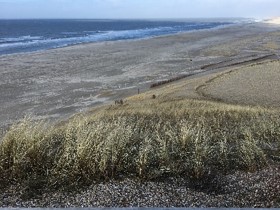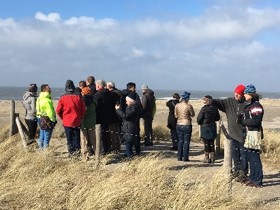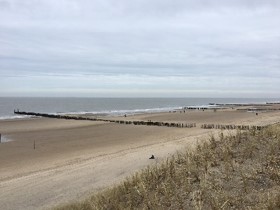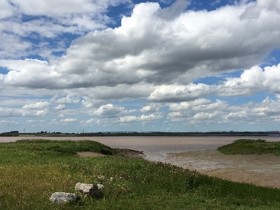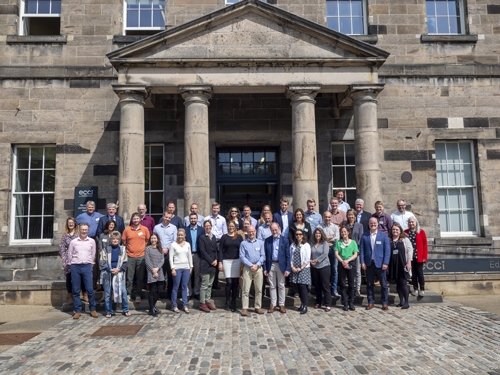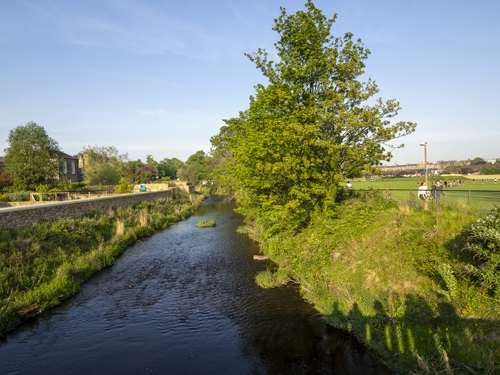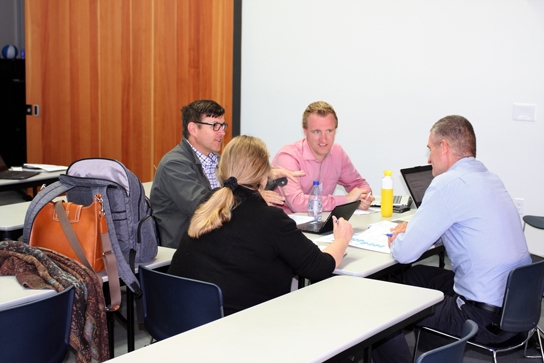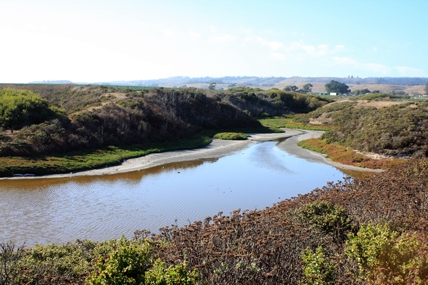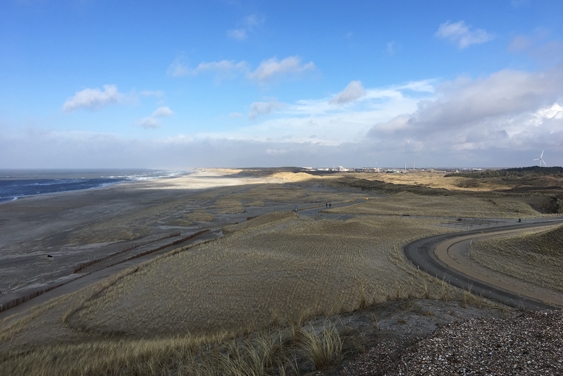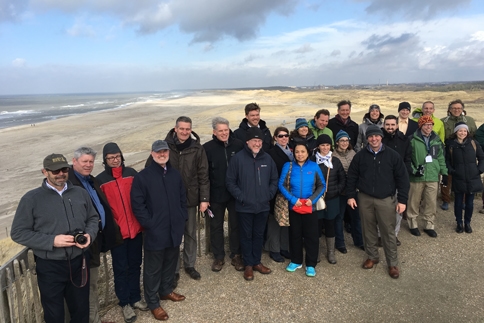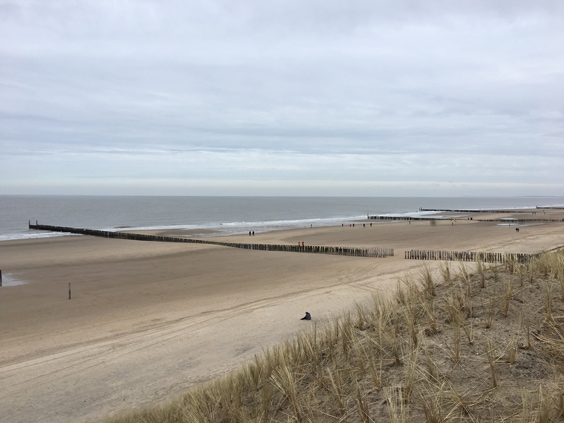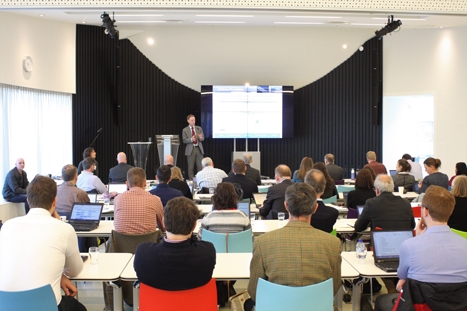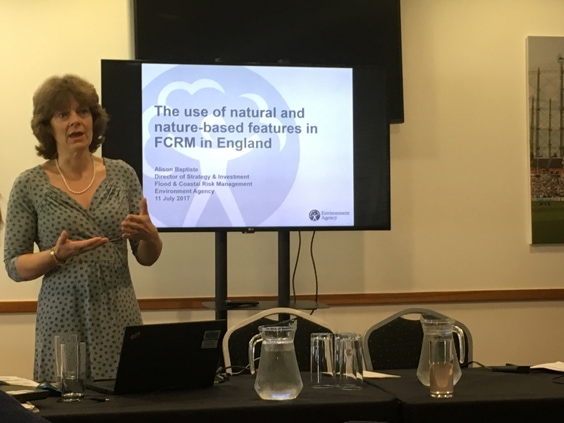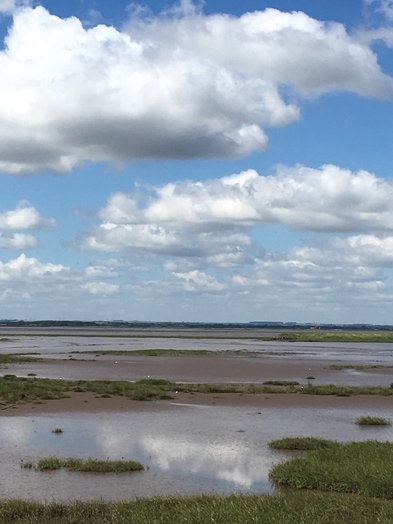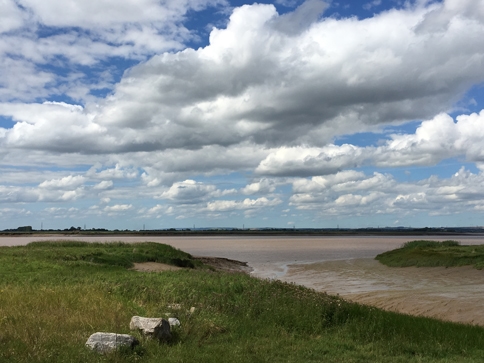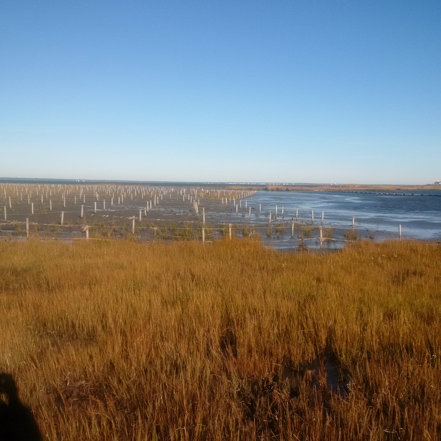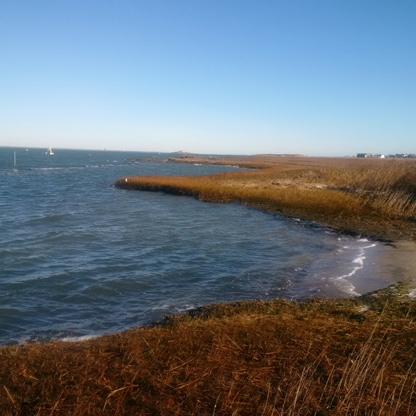Natural and Nature-based Features have been used for decades to support a variety of objectives in coastal and fluvial systems. Beach, dune and river and lake restoration projects have been a longstanding part of flood risk reduction strategies in Europe, the United States and elsewhere. Restoration projects supporting floodplain, wetlands, seagrass, oysters and other habitats and communities have been undertaken around the world to restore ecosystem functions. In more recent years, there has been a growing interest in developing a technically sound engineering approach for integrating NNBF, in combination with conventional flood defense systems (e.g., levees, seawalls, etc.), for more comprehensive and sustainable flood defense. This interest was further stimulated by the outcomes of recent storm and flood events, including Hurricanes Katrina and Sandy in the United States as well as England’s floods in Somerset and Cumbria, which have given rise to a range of studies and projects focused on the role of landscape features in flood risk management. The global dialogue has been underway for several years, including within the Engineering with Nature (EWN) Program in the United States and the Building with Nature (BwN) approach in The Netherlands. Ultimately, these communications have revealed a demand for authoritative guidance on the use of Natural and Nature-Based Features in support of Integrated Water Resources Management.
In order to address the need for guidelines, the US Army Corps of Engineers (USACE) initiated a collaborative project to develop and publish international guidelines on the development and implementation of Natural and Nature-Based Features (NNBF) to support engineering functions in the context of the overall sustainability and resilience of our coasts, bays, and estuaries. Based on subsequent discussions with the Rijkswaterstaat and Deltares in the Netherlands and the Environment Agency and HR Wallingford in the UK, it was proposed to extend the scope to accommodate fluvial systems. The guidelines are planned to address the full project life cycle, including conceptualization, design, engineering, construction, and maintenance. One of the key criteria for the success of the guidelines will be their ability to support the technically sound use of NNBF based on best science and engineering practices. Developing these international guidelines will be a multi-author effort that draws from organizations across all of the relevant sectors, including government, academia, NGOs, engineering firms, construction companies, etc.
To facilitate clear communication within and across the participating organizations, a Scoping Document was prepared. The document sets out both the business case for producing the NNBF Guidelines as well as the overall plan for producing them. The Scoping Document can be found on this webpage. Additionally, information on in-person meetings that have occurred in support of the NNBF Guidelines may also be found as links in the sections listed below.
International NNBF Guideline Meetings and Documents
A multi-agency effort is underway to develop a series of guidance documents to describe how to implement, monitor, and evaluate NNBF.
NNBF Guidelines Project – Spring 2019
Sixth, In-Person Technical Meeting of International Working Group Developing Guidelines for Use of Natural and Nature-Based Features: From May 13th-15th, more than 45 people participated in the sixth, in-person meeting of an international working group being led by USACE to develop guidelines for use of Natural and Nature-Based Features (NNBF). The meeting was hosted by England’s Environment Agency and USACE’s Engineering With Nature (EWN) Initiative at Edinburgh’s Centre for Carbon Innovation, Edinburgh, Scotland. Collectively, attendees at this meeting represented 4 different countries and more than 25 different organizations. This 3-day, in-person meeting was an opportunity to review project progress, advance the development of chapters that will comprise the NNBF Guidelines Document, and select NNBF case studies that will illustrate key concepts within applicable chapters. Exhibits highlighting this meeting are included as links below. Following the working session of the meeting, England’s Environment Agency and USACE’s EWN Initiative hosted an NNBF Symposium at Edinburgh’s Centre for Carbon Innovation, Edinburgh, Scotland, which occurred May 18th -19th, 2019.
Learn more about the NNBF Symposium at Edinburgh’s Centre for Carbon Innovation, Edinburgh, Scotland.
To learn more about the international NNBF symposium and associated workshop follow @NNBFedinburgh on Twitter.
NNBF Guidelines Project – Fall 2018
Fifth, In-person Technical Meeting of International Working Group Developing Guidelines for Use of Natural and Nature-Based Features: From September 19th – 21st, more than 45 people participated in the fifth, in-person meeting of the International Working Group, being led by USACE, which is developing guidelines for use of Natural and Nature-Based Features (NNBF). The meeting was hosted by The Nature Conservancy (TNC) and the US Army Corps of Engineers (USACE) in Santa Cruz, California at the University of California Santa Cruz’s Coastal Biology Building. Collectively, attendees at this meeting represented 4 different countries and more than 20 different organizations. Dr. Todd Bridges, Senior Research Scientist-US Army Engineer Research and Development Center, and Dr. Mike Beck, Lead Marine Scientist-The Nature Conservancy (TNC), provided opening remarks to the group. This 5-day, in-person meeting was an opportunity to review project progress, advance the development of chapters that will comprise the NNBF Guidelines Document, and select NNBF case studies that will illustrate key concepts within applicable chapters. The meeting also provided valuable input through presentations provided during the working session by Mr. Len Materman, Executive Director-San Francisquito Creek Joint Powers Authority, Ms. Monique Fountain, Tidal Wetland Project Director-Elkhorn Slough National Estuarine Reserve, and Dr. Sid Narayan, Research Scientist-University of California Santa Cruz. Following the working session of the meeting, TNC, USACE and UCSC hosted a 1-day NNBF Symposium on September 20th. The meeting concluded on Friday (September 21st) with site visits to the Alviso Ponds, South Bay Salt Pond Restoration Project (Don Edwards San Francisco National Wildlife Refuge and the San Francisquito Creek Restoration Project Sites. Please see 2018 NNBF Symposium, Santa Cruz, California (Should be an internal link) to learn more about the agenda and presentations associated with the symposium held on September 20th.
Guidelines on the Use of Natural and Nature-Based Features for Sustainable Coastal and Fluvial Systems by Todd Bridges, USACE-ERDC
NNBF Guidelines Project – Spring 2018
Fourth, In-Person Technical Meeting of International Working Group Developing Guidelines for Use of Natural and Nature-Based Features: From March 5th – 9th, more than 40 people participated in the fourth, in-person meeting of the International Working Group, being led by USACE, that is developing guidelines for use of Natural and Nature-Based Features (NNBF). The meeting was hosted by Rijkswaterstaat (RWS), Ministry of Infrastructure and Water, and Deltares in Delft, Netherlands. Collectively, attendees at this meeting represented 4 different countries and more than 20 different organizations. Dr. Maarten Smits, CEO Deltares; Dr. Cees Brandsen, Managing Director RWS-Water, Transport and the Environment; Dr. Hans Pietersen, Senior Advisor for International Affairs, RWS; and Dr. Todd Bridges, Senior Research Scientist, ERDC provided opening remarks to the group. This 5-day, in-person meeting was an opportunity to review project progress, advance the development of chapters that will comprise the NNBF Guidelines Document, and select NNBF Case Studies that will illustrate key concepts within applicable chapters. The meeting also provided valuable input through presentations provided by USACE, Deltares and RWS representatives. RWS also arranged site visits for participants to inspect riverine/fluvial or coastal NNBF projects that were constructed in the Netherlands.
NNBF Guidelines Project – Fall 2017
Summary of Third, In-Person Meeting for International Working Group Developing Guidelines for Natural and Nature-Based Features: During October 30th – November 3rd, more than 75 people participated in the third, in-person meeting of the International Working Group that is developing guidelines for use of Natural and Nature-Based Features (NNBF). The meeting was hosted in Silver Spring, MD, at the National Oceanic and Atmospheric Administration (NOAA)’s Headquarters Complex. Collectively, attendees at this meeting represented 3 different countries and more than 30 different organizations. Mr. James Dalton (Director, USACE Civil Works), Dr. Jeff Payne (Director, NOAA’s Office for Coastal Management), and Dr. Eng Seng Loh (Director, Caterpillar’s Strategic Growth Projects-Earthmoving Division) offered opening remarks to the attendees. This 5-day, in-person meeting was an opportunity to review project progress, advance the development of 10 chapters, and identify/discuss NNBF Case Studies that will illustrate key concepts within applicable chapters. The meeting also provided valuable input through presentations of USACE, NOAA and Maryland Dept. of Natural Resources’ applicable programs/projects and afforded opportunities to conduct NNBF site visits in Maryland and Washington, DC.
Presentation
Guidelines on the Use of Natural and Nature-Based Features for Sustainable Coastal and Fluvial Systems presented by Todd S. Bridges
NNBF Guidelines Project – Summer 2017
Summary of Second, In-Person Meeting for International Working Group Developing Guidelines for Natural and Nature-Based Features: During June 10-13, 2017, Dr. Todd Bridges, Dr. Jeff King, Dr. Todd Swannack, Dr. Candice Piercy, Dr. Joe Gailani, and Mr. Tim Welp participated in a second, in-person meeting of the International Working Group that is developing guidelines for use of Natural and Nature-Based Features (NNBF). The meeting was hosted in the United Kingdom by the Environment Agency. More than 25 contributors, representing 4 countries and more than 10 different organizations, assembled to continue their ongoing efforts that will produce the guidelines document. This 4-day, in-person meeting was an opportunity to review progress, incorporate a NNBF chapter applicable to riverine/fluvial systems, and advance four priority chapters within the guidelines document. The meeting also provided valuable input through presentations of applicable UK programs and/or projects, and it culminated with a series of site visits that occurred along the UK’s eastern coastline.
NNBF Guidelines Project – Fall 2016
Summary: On October 25th, 2016, the United States Army Corps of Engineers (USACE)’s Engineering Research and Development Center (ERDC) hosted a two-day workshop to initiate the development of international guidelines to inform the conceptualization, planning, design, engineering, construction, and maintenance of Natural and Nature-based Features (NNBF) that are used to support resilience and flood risk reduction for coasts, bays, and estuaries. An international team of more than 30 authors and contributors assembled at ERDC’s Environmental Laboratory to begin work on this initiative.
Background: NNBF refers to those features that define natural coastal landscapes and are either naturally occurring or engineered to mimic natural conditions. Some examples of NNBF are beaches and dunes, salt marshes, oyster reefs and barrier islands. International interest is growing with respect to use of NNBF as part of a coastal inundation solution that mitigates flood risks to coastal communities while providing ecosystem services. However, there are presently no NNBF guidelines available to support practitioners and/or stakeholders that are interested in the use of these engineered features. A kick-off meeting (October 25-26, 2016) assembled an international team that will prepare such guidance. The attendees (31 total authors/contributors) represented government agencies, private sector engineering and construction companies, universities, and NGOs from the United States, United Kingdom, the Netherlands, Republic of Korea, and New Zealand, and their affiliated organizations included: USACE, the Dutch Rijkswaterstaat, Deltares, the UK Environment Agency, the National Oceanic and Atmospheric Administration, the Korea Institute for Ocean Science and Technology, Stanford University, Caterpillar Corporation, Great Lakes Dredge and Dock, Anchor QEA, Biohabitats, Inc., Ecology & Environment, Inc., LimnoTech, Ramboll, Tonkin and Taylor, and HR Wallingford. Three individuals representing academic institutions (University of Maryland, Rutgers University and US Naval Academy) were also able to participate in portions of the meeting by phone. This initial meeting provided attendees a location and time to discuss the overall organization of the effort, develop a draft structure for the guidelines, and initially refine/expand chapter outlines. Additional organizations will be participating in future meetings and contributing to development of the NNBF Guidelines.
Outcomes: Authors and contributors provided their perspectives concerning the guidelines’ structure and initial draft of the working outline through a series of discussions that occurred in general (plenary) sessions and breakout groups. Their focused, creative and productive dialogues resulted in the following:
- An updated working outline for the Guidelines Document that includes notes and an expanded outlines for each of the currently identified chapters, which was based on breakout group discussions;
- Draft outline for the business case document in support of this collaborative project. The business case document will be developed to substantiate the value of committing time and resources towards the creation of the NNBF guidelines by an international team of contributors; and
- A tentative schedule for completing and publishing the NNBF Guidelines Document (tentatively scheduled for fall 2018).
Next Steps: The immediate next steps include the following:
- Drafting teams (established during breakout groups) will continue to develop the content of the guidelines and business case document over the coming months leading to the next working meeting in spring 2017;
- Drafting teams will also begin developing a list of case study examples (including brief descriptions) to include within the NNBF Guideline Document.
As a first step in the NNBF Guidelines development process, an international team developed a Scoping Document. The Scoping Document is offered to the home institutions of project team members for the purpose of describing the global need for the project.
Project Scoping Document: Guidelines on the Use of Natural and Nature-Based Features for Sustainable Coastal and Fluvial Systems (PDF)

